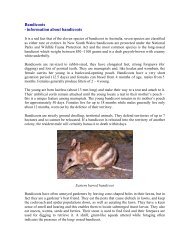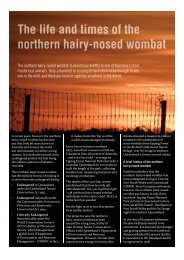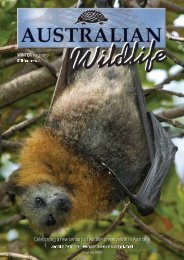Wildlife Preservation Autumn 2012.indd - Wildlife Protection Society ...
Wildlife Preservation Autumn 2012.indd - Wildlife Protection Society ...
Wildlife Preservation Autumn 2012.indd - Wildlife Protection Society ...
You also want an ePaper? Increase the reach of your titles
YUMPU automatically turns print PDFs into web optimized ePapers that Google loves.
When echidnas wake from<br />
hibernation they often become<br />
disorientated. Many have been found<br />
under carports with a brick wall and<br />
concrete. All they need is to be turned<br />
around and headed back in the right<br />
direction. Most have wandered in<br />
from local parks or scrub.<br />
Never remove a healthy echidna from<br />
the area in which it is found. It could<br />
be a female echidna with a puggle in a<br />
burrow nearby. If you take the mother<br />
away to relocate in another area, her<br />
baby will starve to death. Echidnas have<br />
also been known to try to nd their way<br />
back home. They then face the risk of<br />
having to cross roads and being hit by<br />
cars.<br />
An echidna does not have ear aps like<br />
we do. Its ears are large, vertical slits<br />
just behind its eyes. It has an amazing<br />
sense of smell, therefore if needing to<br />
capture an echidna you must approach<br />
it from downwind so that it cannot<br />
smell you. It was once believed that<br />
echidnas had extremely poor eyesight,<br />
however, latest ndings show the exact<br />
opposite is true.<br />
Many thanks to everyone who provided<br />
photos and to Fourth Crossing <strong>Wildlife</strong><br />
for photos and information.<br />
The majority of this article came<br />
from the book by Dr Peggy Resmiller<br />
“Biology Rescue and Rehabilitation of<br />
Short-Beaked Echidnas”.<br />
Thank you Dr Peggy Resmiller for<br />
allowing us to utilise this great source.<br />
Credits: http://www.telegraph.co.uk<br />
In the Wild<br />
with Harry Butler<br />
There’s something else that’s not a bird, though it does lay eggs. It’s<br />
something special – probably the most primitive mammal in the world,<br />
except for the platypus. It’s the Echidna or Spiny Anteater. As soon as it<br />
sees me he goes into his defensive position – but the poor fellow’s got one<br />
problem: his hind claws are so well developed for digging that one has to<br />
stick out. If you touch one it retreats, but the other one has to poke out, so<br />
you can get a grip on him. It’s the one weakness in his protection against<br />
foxes and dingoes and other predators.<br />
He has a lovely long nose and seven inches of tongue. He’s out hunting for<br />
termites: most mammals here come out at night, but this one’s an exception.<br />
He comes out in the afternoon and goes termite-hunting, scu ing around<br />
in the bushes looking for termites which live just under the surface. He digs<br />
with his powerful claws and then ... slurp! Seven inches of instant death goes<br />
up the tunnel and zaps the termites. He eats about three or four thousand of<br />
them in a day.<br />
His back claw is very long for obvious reasons: how do you scratch yourself<br />
if you get an itch under all those prickles? That long claw is for getting in<br />
among the spines and having a good old scratch, because he gets ticks and<br />
lice the same as other things do in the bush.<br />
He’s threatened by one of our introduced animals, the fox, who’s learned<br />
a way to handle Echidnas. The fox comes along, the Echidna sees him<br />
and rolls up in a tight ball. The fox will roll him with his nose to a pool of<br />
water, if there’s one handy, and as soon as he hits the water the Echidna<br />
unrolls to start swimming and – zap! The fox has got him, because the belly<br />
underneath is soft and unprotected.<br />
A good size tub to move an echidna.<br />
Photo: Terri Eather<br />
Baby echidna currently in care with WIRES.<br />
Photo: Alicia Carter<br />
Echidna contained. Terri Eather<br />
Nestling echidnas only require milk once<br />
every 48 hours. A puggle fat from a good feed.<br />
Source: perthzoo.wa.gov.au/via: zooborns.com<br />
40 Australian <strong>Wildlife</strong> Vol 2 - <strong>Autumn</strong> 2012





